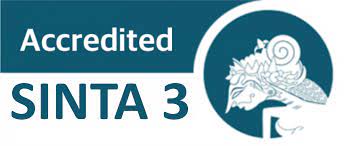Technology in ELT contexts: does Google Classroom provide satisfactory online classrooms climate for university students?
Abstract
For more than two decades, online learning has been employed to replace f2f instructions. GC has widely recognized to manage digital learning environment. While extensive research has investigated digital classroom mediated by GoogleClassroom (GC), there is paucity of research exploring participants’ views about GC-mediated online learning situated in Indonesian higher education (HE) contexts. We employed a sequential-explanatory research (Creswell, 2018; 2014) intended to explore in-depth the undergraduate students’ perceptions about the in-class use of Google Classroom in EFL settings. There were six (N=6) undergraduate students from private Indonesia university consented to participate in this study. We administered a web-based five point Likert scale questionnaire to collect any necessary data. Also, a semi-structured interview was conducted to explore their in-depth feelings to the selected participants. The results indicated that GC offered enormous potential benefits for organizing online teaching-learning processes. Implications, conclusions, limitations, and recommendations were then discussed.
Keywords
Full Text:
PDFReferences
Abazi-bexheti, L., Kadriu, A., & Apostolova-trpkovska, M. (2018). LMS Solution : Evidence of Google Classroom Usage in Higher Education. Business Systems Research, 9(1), 31–43. https://doi.org/10.2478/bsrj-2018-0003
Al-emran, M., Elsherif, H. M., & Shaalan, K. (2016). Computers in Human Behavior Investigating attitudes towards the use of mobile learning in higher education. Computers in Human Behavior, 56(23), 93–102. https://doi.org/10.1016/j.chb.2015.11.033
Al-emran, M., Mezhuyev, V., & Kamaludin, A. (2018). SC. Computers & Education. 26(07), 1-43 https://doi.org/10.1016/j.compedu.2018.06.008
Al-maroof Saeed, R. A., & Al-emran, M. (2018). Students Acceptance of Google Classroom : An Exploratory Study using PLS-SEM Approach. I-Managers Journal on Mobile Applications & Technologiesjet, 13(6), 112–123. https://doi.org/10.3991/ijet.v13i06.8275 Rana
Alemi, M., Sarab, A. R. M., & Lari, Z. (2012). Successful Learning of Academic Word List via MALL : Mobile Assisted Successful Learning of Academic Word List via MALL : Mobile Assisted Language Learning. 5(6), 99–109. https://doi.org/10.5539/ies.v5n6p99
Alqahtani, A. (2019). Journal of Technology and Science Education. 9(3), 326–339.
Andujar, A. (2016). Bene fi ts of mobile instant messaging to develop ESL writing. System,10(16), 1–14. https://doi.org/10.1016/j.system.2016.07.004
Azar, S. A., & Nasiri, H. (2014). Learners ’ Attitudes toward the Effectiveness of Mobile Assisted Language Learning ( MALL ) in L2 Listening Comprehension. Procedia - Social and Behavioral Sciences, 98(20), 1836–1843. https://doi.org/10.1016/j.sbspro.2014.03.613
Burner, T. (2015). Formative assessment of writing in English as a foreign language Formative assessment of writing in English as a foreign language. Educational Research, 60(6), 1–23. https://doi.org/10.1080/00313831.2015.1066430
Christensen, R. (2014). Journal of Research on Technology in Education Effects of Technology Integration Education on the Attitudes of Teachers and Students. Journal of Research on Technology in Education, 34(4), 441–433. https://doi.org/10.1080/15391523.2002.10782359
Chuaphalakit, K., Inpin, B., & Coffin, P. (2019). A Study of the Quality of Feedback Via the Google Classroom-mediated-Anonymous Online Peer Feedback Activity in a Thai EFL Writing Classroom *. International Journal of Progressive Education, 15(5), 103–118. https://doi.org/10.29329/ijpe.2019.212.8
Cohen, L., Manion, L., & Morrison, K. (2007). Research Methods in Education (6 Edition). by Routledge, 1-638.
Creswell, Jhon w. (2018). Research Design Qualitative, Quantitative, and Mixed Methods Approaches. SAGE publications.
Creswell, John w. (2014). Research Qualitative, Quatitative, And Design (J. Young (ed.); 4 edition). SAGE publications. https://doi.org/1362.069632014
Currie, B. (2016). Transforming Lessons With Technology. 8958(February), 16–21. https://doi.org/10.1080/00228958.2016.1123040
Dörnyei, Z., & Taguchi, T. (2010). Questionnaires in Second Language Research: Construction, Administration, and Processing (2 Edition). Routledge (Taylor & Francis e-Library).
Ebadi, S., & Rahimi, M. (2017). Exploring the impact of online peer-editing using Google Docs on EFL learners ’ academic writing skills : a mixed methods study. Computer Assisted Language Learning, 30(8). https://doi.org/10.1080/09588221.2017.1363056
Elaish, M. M., Shuib, L., & Ghani, N. A. (2017). Mobile English Language Learning ( MELL ): a literature review Mobile English Language Learning ( MELL ): a literature review. Educational Review, 1911(November), 1–20. https://doi.org/10.1080/00131911.2017.1382445
Erişti, S. D., & Kurt, A. askim. (2012). Teachers ’ Views about Effective Use of Technology in Classrooms. Turkish Online Journal of Qualitative Inquiry, 3(April), 30–41.
Gülbahar, Y. (2007). Technology planning : A roadmap to successful technology integration in schools. Computers and Education, 49(23), 943–956. https://doi.org/10.1016/j.compedu.2005.12.002
Gupta, A., & Pathania, P. (2020). To study the impact of Google Classroom as a platform of learning and collaboration at the teacher education level. Education and Information Technologies, 1. https://doi.org/10.1007/s10639-020-10294-1 To
Hammersley, M., & Trainanou, A. (2012). Ethics in Qualitative Research: Controversies and Contexts. In Evaluation Journal of Australasia, 23(1), https://doi.org/10.1177/1035719x1301300107
Heggart, K. R., & Yoo, J. (2018). Getting the Most from Google Classroom : A Pedagogical Framework for Tertiary Educators. Australian Journal of Teacher Education, 43(3), 140–153.
Hussein, M. H., Ow, S. H., Ibrahim, I., & Mahmoud, M. A. (2020). Measuring instructors continued intention to reuse Google Classroom in Iraq: a mixed-method study during COVID-19. Interactive Technology and Smart Education. https://doi.org/10.1108/ITSE-06-2020-0095
Iftakhar, S. (2016). Google classroom: what works and how? 3 (2), 12–18. Journal of Education and Social Sciences, ISSN 2289-9855
Ivankova, N. V, Creswell, J. W., & Stick, S. L. (2006). Sequential Explanatory Design : From Theory to Practice. Field Methods, 18(3), 3–20. https://doi.org/10.1177/1525822X05282260
Izenstark, A., & Leahy, K. L. (2015). Google classroom for librarians: features and opportunities. Library Hi Tech News, 32(9), 1–3. https://doi.org/10.1108/LHTN-05-2015-0039
Klimova, B., & Berger, A. (2018). Evaluation of the Use of Mobile Application in Learning English Vocabulary and Phrases – A Case Study. Springer Nature Switzerland, 1, 3–11. https://doi.org/10.1007/978-3-030-03580-8
Klimova, B., & Toman, J. (2020). Effectiveness of the Blended Learning Approach in Teaching and Learning Selected EFL Grammar Structures at a University Level – A Case Study. In S. K. S. Cheung, R. Li, K. Phusavat, N.
Paoprasert, & L. Kwok (Eds.), Blended Learning Education in a Smart Learning Environment (pp. 1–418). Springer Nature Switzerland AG 2020. https://doi.org/10.1007/978-3-030-51968-1
Kukulska-hulme, A., Shield, L., & Kukulska-hulme, A. (2014). An overview of mobile assisted language learning : From content delivery to supported collaboration and interaction collaboration and interaction. May, 271–289. https://doi.org/10.1017/S0958344008000335
Kumar, B. A., & Chand, S. S. (2018). Mobile learning adoption : A systematic review. Education and Information Technologies, 13(2). https://doi.org/10.1007/s10639-018-9783-6
Kumar, J. A., Bervell, B., & Osman, S. (2020). Google classroom: insights from Malaysian higher education students’ and instructors’ experiences. Education and Information Technologies, 25(5), 4175–4195. https://doi.org/10.1007/s10639-020-10163-x
Kumar, J., & Bervell, B. (2019). Google Classroom for mobile learning in higher education : Modelling the initial perceptions of students. Education and Information Technologies, 16, 1793–1817. https://doi.org/10.1007/s10639-018-09858-z Google
Lam, J., Yau, J., & Cheung, S. K. S. (2010). A Review of Mobile Learning in the Mobile Age. 2(2005), 306–315.
Lan, Y., & Sie, Y. (2010). Computers & Education Using RSS to support mobile learning based on media richness theory. Computers & Education, 55(2), 723–732. https://doi.org/10.1016/j.compedu.2010.03.005
Lee, H., Hampel, R., & Kukulska-hulme, A. (2019). Gesture in speaking tasks beyond the classroom : An exploration of the multimodal negotiation of meaning via Skype videoconferencing on mobile devices. System, 81, 26–38. https://doi.org/10.1016/j.system.2018.12.013
Lee, N. (2016). To Google or Not to Google. Springer Science+Business Media New York, 3–52. https://doi.org/10.1007/978-1-4939-6415-4
Lyddon, P. A. (2016). Mobile-assisted language learning and language learner autonomy Mobile-assisted language learning and language learner autonomy. EURO CALL, 1, 302–306. https://doi.org/10.14705/rpnet.2016.eurocall2016.579
Manfreda, K. L., & Vehovar, V. (2008). Internet surveys. In E. D. De Leeuw, J. J. Hox, & D. A. Dillman (Eds.), International Handbook of Survey Methodology (pp. 264–284). Routledge.
Martin, F., & Ertzberger, J. (2013). Computers & Education Here and now mobile learning : An experimental study on the use of mobile technology. Computers & Education, 68, 76–85. https://doi.org/10.1016/j.compedu.2013.04.021
Miangah, T. M., & Nezarat, A. (2012). Mobile-Assisted Language Learning. International Journal of Distributed and Parallel Systems, 3(1), 309–319. https://doi.org/10.5121/ijdps.2012.3126
Moreno, A. I., & Vermeulen, A. (2015). Using VISP ( VIdeos for SPeaking ), a mobile app based on audio description , to promote English language learning among Spanish students : a case study . Procedia - Social and Behavioral Sciences, 178(November 2014), 132–138. https://doi.org/10.1016/j.sbspro.2015.03.169
Perrotta, C., Gulson, K. N., Williamson, B., Witzenberger, K., Perrotta, C., Gulson, K. N., Williamson, B., Witzenberger, K., Perrotta, C., Gulson, K. N., & Williamson, B. (2020). Critical Studies in Education Automation , APIs and the distributed labour of platform pedagogies in Google Classroom Automation , APIs and the distributed labour of platform pedagogies in Google Classroom. Critical Studies in Education, 00(00), 1–17. https://doi.org/10.1080/17508487.2020.1855597
Sarrab, M. (2015). M-learning in education : Omani Undergraduate students perspective. Procedia - Social and Behavioral Sciences, 176, 834–839. https://doi.org/10.1016/j.sbspro.2015.01.547
Sarrab, M., Al-shihi, H., Al-manthari, B., & Bourdoucen, H. (2018). Toward Educational Requirements Model for Mobile Learning Development and Adoption in Higher Education.
Syed Ahmad, T. S. A., Ramlan, Z. S., & Kumar Krishnan, S. (2020). Acceptance of Google Classroom for Learning English Exit Test. International Journal of Modern Languages And Applied Linguistics, 4(1), 67. https://doi.org/10.24191/ijmal.v4i1.9504
Widodo, P. (2014). METHODOLOGICAL C ONSIDERATIONS IN I NTERVIEW DATA TRANSCRIPTION. International Journal of Innovation in English Language, 3(1), 101–107. https://doi.org/2156-5716
Wu, W., Wu, Y. J., Chen, C., Kao, H., & Lin, C. (2012). Computers & Education Review of trends from mobile learning studies : A meta-analysis. Computers & Education, 59(2), 817–827. https://doi.org/10.1016/j.compedu.2012.03.016
Yousafzai, A., Chang, V., Gani, A., & Noor, R. (2016). International Journal of Information Management Multimedia augmented m-learning : Issues , trends and open challenges. International Journal of Information Management, 36(5), 784–792. https://doi.org/10.1016/j.ijinfomgt.2016.05.010
DOI: https://doi.org/10.18860/abj.v7i1.14511
Refbacks
- There are currently no refbacks.
Copyright (c) 2022 Abjadia

This work is licensed under a Creative Commons Attribution-NonCommercial 4.0 International License.
...............................................................................................................................................................
Mailing Address:
Ruang Jurnal Abjadia, Fakultas Ilmu Tarbiyah dan Keguruan (FITK)
Universitas Islam Negeri (UIN) Maulana Malik Ibrahim Malang
Jalan Gajayana 50 Malang 65144, Jawa Timur, Indonesia
Phone/Faximile: (+62341) 552398, Cell Phone: +62 81 333 666 063
Website: http://ejournal.uin-malang.ac.id/index.php/abjadia
Email: abjadia@uin-malang.com
Abjadia: International Journal of Education. This work is licensed under a Creative Commons Attribution-ShareAlike 4.0 International License.
...............................................................................................................................................................
Indexed by:







